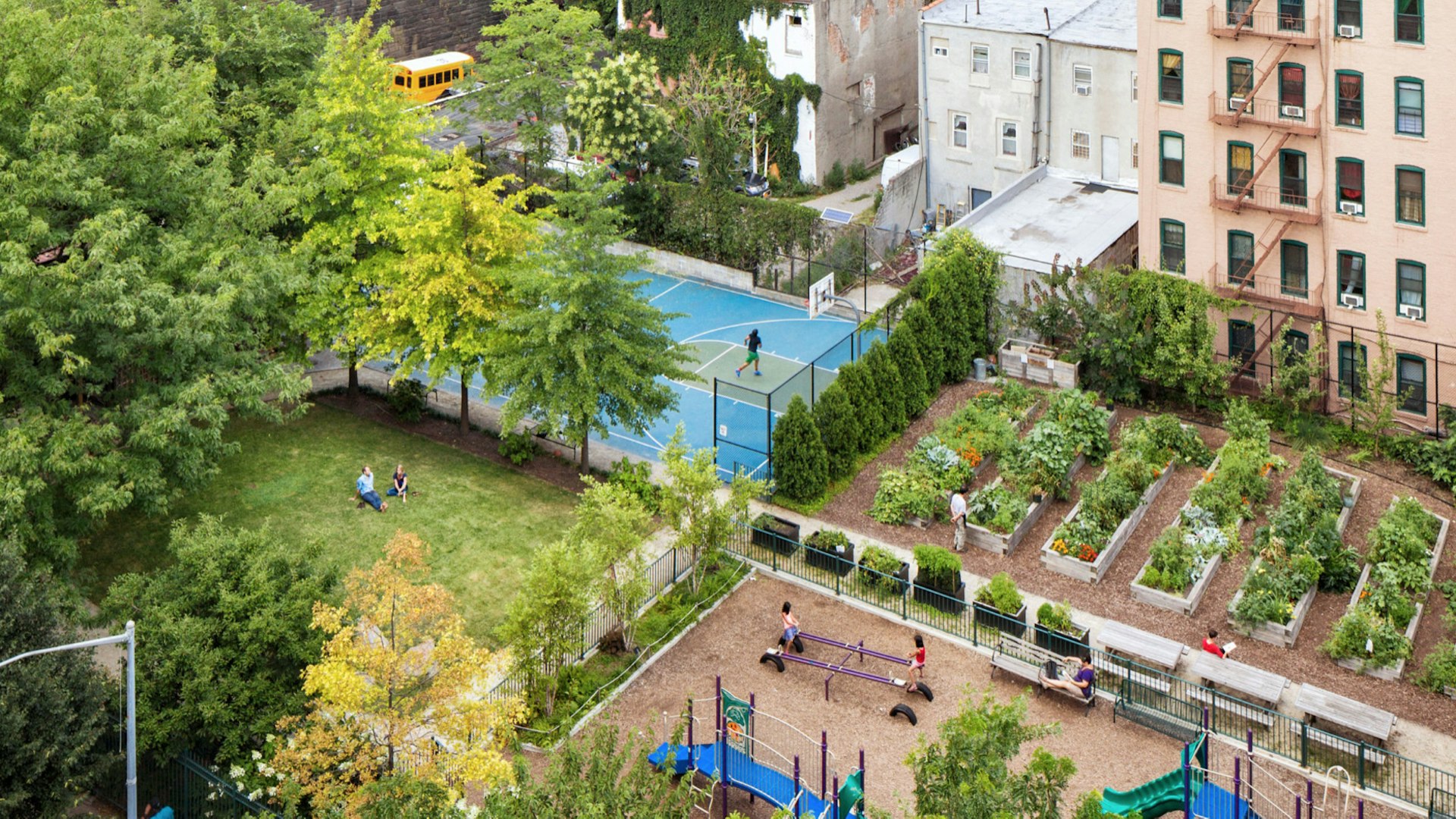magazine_ Article
Just Nature
Can some of the most pressing urban problems be solved with the help of nature?
A patch of green, a piece of justice. Through community gardens, people in disadvantaged neighbourhoods can also enjoy nature and all the associated benefits. The 103rd Street Community Garden in East Harlem, New York, was co-planned by the residents of the neighborhood and created with little money and a lot of volunteer work.
Credit: Ty Cole | All rights reserved
Green façades and roof gardens to cool concrete deserts, wetlands as water catchment basins, moss walls that bind fine dust, and more habitats for animals and plants everywhere. Cities around the world are responding to climate change and biodiversity loss with so-called nature-based solutions. A large European research project is developing ways to better exploit the potential with the ambitious goal of ensuring that the advantages primarily benefit the previously disadvantaged.
Ever wondered if the affluent amongst us breathe a better quality of air? If the neighbourhoods they inhabit look, smell and sound better? Do their gardens full of old trees echo with the sound of birds chirping in the morning? What about their weekends - do they head to a second home in idyllic countryside? After talking to spatial planning expert Sonja Gantioler, one asks oneself such questions and more along the same lines. How often do these people, who experience busy roads mainly from the comfort of their cars, take a plane trip? How do they get to these second homes? And there explains Gantioler, you have the "discrepancy” that unfortunately characterises not only our cities but also the globe as a whole: those whose lifestyles are responsible for a lot of emissions are generally not among the group of people who feel their painful consequences. Furthermore, it is the generally lucky few who have more weight in urban planning and environmental policy decision-making processes. A glaringly obvious injustice, but who’s doing anything about it?
Justice - in relation to the distribution of environmental goods - is a central theme of Sonja Gantioler's research. In addition to biology, she studied environmental economics and politics, and her dissertation is focused on how equitable access to ecological city spaces can be guaranteed. Currently the researcher is bringing her interest in ecological and social systems to a new, large EU project examining nature -based solutions. Over the next five years, seven European cities will implement a wide range of measures that use nature to address social challenges - preferably in a way that counteracts preexisting social inequality.
Nature doesn’t perform like that.
Sonja Gantioler
In the most general terms, nature-based solutions are designed to help us adapt to or protect ourselves from the effects of climate change, reduce emissions, enhance biodiversity and improve human well-being. In concrete terms, examples around the world show an impressive range of services. Reforestation and forest conservation, for example, can prevent erosion and sequester carbon. In the basin of Lake Poyang, China's largest freshwater lake, such measures have reduced soil erosion by half over the past 25 years, while increasing carbon sequestration by five times and farmers' net income by six times. On coasts, ecosystems such as coral reefs, seagrass beds and mangroves are used to protect against extreme weather events and rising sea levels, with proven benefits, studies show.
In cities, nature-based solutions are supposed to be particularly effective against the increasingly acute problems of heat islands, flooding after heavy rains, air pollution and dwindling biodiversity. Depending on location and circumstances, one goal usually takes priority, but all measures have one wonderful thing in common: they never solve just one problem. For example, green spaces and planted façades or roofs provide cooling through shading and evaporation, but at the same time they store water during heavy rains and release it again over a longer duration - the concept of the "sponge city" was all the rage after the floods in Germany last summer, on top of this they are also habitat for birds, small animals and insects, thus promoting biodiversity; their leaves bind particulate matter and nitrogen oxides; on green roofs there is room for vegetable gardens or even beehives as the roof of Bolzano’s Exhibition Center can attest. Planted in strategic locations, green spaces can make people drive more slowly lower and finally, having greener streets incentivizes people to walk or cycle, which benefits their health as well as the environment. The list of positive effects goes on, from the essential importance of bees, to the benefits of home-grown vegetables and the relaxation of the amateur gardener... "These solutions are not about maximizing a function: That's not how they work and that's not where they can or should compete with technical solutions - their enormous diversity is their strength," Gantioler explains. She has a problem with the fact that "key performance indicators" always have to be named in project proposals and, "Nature doesn't perform like that."
Creating playgrounds out of wasteland
The solutions that will be adopted in the seven cities are all still in the conceptual phase. To initiate with highly detailed and fastidiously pre-planned interventions would go against the philosophy of the project, which is designed to never lose sight of equity. Before planning even begins, essential questions must be asked - who should be asked what the requirements are? Who will be given the opportunity to express their opinions? "The people who live in a space and experience it on a daily basis are the most competent experts to ask". The challenge, according to Gantioler, is to design participation processes in such a way that it is not always the same groups and generations that have a voice. It means balancing the opinion of those who live in areas with low concentrations of particulate matter and who therefore do not have such a realistic perception of pollution damage. "We will need to think about power dynamics, break structures, or rather, at least start this process...", she laughs, "this vision we are aiming for is quite an ambitious task". Asked to name a model city for this type of participatory approach, Gantioler cites New York: "A platform was created to identify certain brownfields (unused and previously developed land) in the city. The system allowed people to come together to plan the future of these areas. In this way, community gardens or free spaces for children to play in were created.
How to quantify the value of such solutions? Although experts now have a certain amount of practice in expressing the services that ecosystems provide for us in monetary terms, there is still uncertainty in calculating the lateral benefits - for example, how much would it be worth if children can play outdoors in an abandoned urban wasteland instead of sitting in front of a PlayStation? Time also plays a role, because nature-based solutions often only reveal their full effect long after the initial costs are incurred. In fact, one study concluded the benefits of nature-based solutions are systematically underestimated in analyses, and as such investments are more likely to be withheld.
Nevertheless, there is a consensus that these solutions are very cost-effective for society as a whole, and that a lot can be achieved with comparatively little financial effort. And it also pays off for private individuals to invest in green façades and roofs. Cooling costs are reduced, the risk of flooding diminishes, and recent studies have shown that PV systems on green roofs are significantly more efficient than on their normally roofed counterparts. Nevertheless, private investors often prefer technological solutions, explains Gantioler, because the costs seem more manageable, while solutions that rely on ecosystems give rise to fears of incalculable expenses for maintenance and care. "But often there's too much of a gardener's idea of how much you have to work on something all the time - sometimes you're allowed to just leave things alone." It is not the perfectly manicured park with trimmed hedges that we must strive for, rather it is precisely informal areas, where what grows is what would naturally grow – these are the true hotspots of biodiversity.
Double dangers
However, building on potentially abundant areas cannot simply be offset by adding a green roof and an ivy façade (although this is of course preferable to a pure glass-and-concrete palace). "This doesn't deliver the same functions," says Gantioler. There is a danger, she says, that nature-based solutions are put on top of building projects as an end-of-pipe compensatory measure, because this seems easier than thinking about ways of preserving and integrating existing natural structures. Experts see another danger: that the enthusiasm for nature-based solutions distracts from the urgent need for decarbonization. This was also a central criticism of the moss wall that was tested at Stuttgart's Neckartor to reduce one of Germany's highest particulate pollution levels: money was spent on a green patch instead of investigating mitigation methods for the car-oriented city. The moss, too exposed to the sun, struggled to survive and no quantitative effect could be detected in the air.
"The problem is so complex that there can't be just one solution. You have to use many levers," says Gantioler. One of them can be to copy nature: for example, to use materials that, like the surfaces of many plants, reflect solar radiation to a high degree. Whether one still wants to call this "nature-based" depends on how one understands the definition. Some aspects of human well-being, however, cannot be improved by such imitative solutions. Especially in disadvantaged neighbourhoods, studies have shown, "nature" creates a stronger sense of identification, belonging and community. However, the same measures can have a completely different effect depending on the framework conditions: In the USA, neighbourhoods where parks or trees were planted in private-public partnerships experienced gentrification - house prices rose, lower income groups felt excluded. Cities may have become greener, but social disparity was felt more keenly.
More information about the project: https://cordis.europa.eu/project/id/101003757









